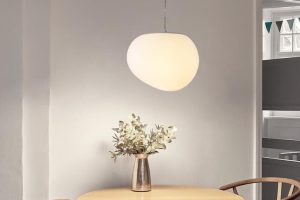
Enhance Your Home Office with the Perfect Lamp
When selecting lighting for a space, it is crucial to consider both aesthetics and functionality. Various lighting options cater to different design preferences, from modern to traditional styles. Modern spaces may benefit from pendant lights or track lighting, which offer a sleek and customizable appearance.
Traditional interiors can be enhanced with chandeliers or wall sconces, available in diverse styles and finishes to complement existing decor. Functionality is equally important when choosing lighting. Task lighting, such as under-cabinet fixtures or adjustable floor lamps, provides focused illumination for specific areas like kitchen counters or reading nooks.
Ambient lighting, including recessed lights or wall-mounted fixtures, creates a warm and inviting atmosphere suitable for entertaining or relaxation. The choice of lighting can significantly impact a room’s overall ambiance and usability. By carefully considering both style and function, one can select lighting options that not only enhance the visual appeal of a space but also meet practical needs for illumination in various activities and settings.
Understanding Different Types of Lighting
Ambient Lighting: Setting the Mood
Ambient lighting provides general, overall illumination in a room, typically through ceiling-mounted fixtures such as chandeliers or recessed lighting. This type of lighting helps create a comfortable and inviting atmosphere, making it essential for everyday activities.
Task and Accent Lighting: Focused Illumination
Task lighting is designed to provide focused illumination for specific tasks like reading, cooking, or working at a desk. This type of lighting is typically provided by fixtures such as desk lamps, under cabinet lighting, or pendant lights. Accent lighting, on the other hand, highlights specific features or areas in a room, such as artwork, architectural details, or decorative objects, adding visual interest and drama to a space.
Color Temperature: Warmth and Coolness
In addition to understanding the different types of lighting, it’s also important to consider the color temperature of the light. Measured in Kelvin (K), color temperature refers to the warmth or coolness of the light. Lower color temperatures (2700K-3000K) produce a warm, yellowish light, often used in living spaces and bedrooms to create a cozy atmosphere. Higher color temperatures (3500K-4100K) produce a cool, bluish light, often used in workspaces and kitchens to provide bright, energizing illumination. By understanding the different types of lighting and color temperatures, you can choose the right fixtures and bulbs to create the perfect ambiance for your space.
Finding the Right Size for Your Space
When it comes to finding the right size lighting for your space, it’s important to consider both the scale of the room and the specific function of the fixture. For larger rooms with high ceilings, consider oversized fixtures such as chandeliers or pendant lights to make a bold statement and fill the space with light. These types of fixtures can help to create a focal point in the room and add visual interest to an otherwise empty space.
On the other hand, for smaller rooms or spaces with lower ceilings, consider smaller fixtures such as flush mount or semi-flush mount lights. These types of fixtures are designed to provide ample light without overwhelming the space and can be a great option for areas such as hallways, closets, or bathrooms. In addition to considering the scale of the room, it’s also important to think about the specific function of the fixture.
For example, if you’re looking for a dining room chandelier, consider the size and shape of your dining table when choosing a fixture. A general rule of thumb is to choose a chandelier that is about half the width of the table, but this can vary depending on the size and shape of your table. Similarly, if you’re looking for pendant lights for a kitchen island, consider the length and width of the island when choosing a fixture.
It’s important to choose a fixture that is proportionate to the size of the island and provides adequate illumination for cooking and meal prep.
Incorporating Adjustable Features
When it comes to incorporating adjustable features into your lighting design, there are a variety of options to choose from that can help you customize the illumination in your space. One popular option is dimmable lighting, which allows you to adjust the brightness of the fixture to create the perfect ambiance for any occasion. Dimmable fixtures are available in a wide range of styles and can be easily integrated into any room to provide flexible lighting options.
Another adjustable feature to consider is directional lighting, which allows you to adjust the angle and direction of the light to focus on specific areas or objects in the room. This type of lighting is perfect for highlighting artwork, architectural details, or other decorative elements in your space. In addition to dimmable and directional lighting, consider fixtures with adjustable arms or heads that allow you to customize the direction and spread of light.
For example, floor lamps with adjustable arms can be positioned to provide task lighting for reading or working at a desk, while track lighting with adjustable heads can be used to highlight different areas in a room. These types of fixtures are perfect for spaces that require versatile lighting options and can help you create a customized illumination plan that meets your specific needs. By incorporating adjustable features into your lighting design, you can create a versatile and functional space that is tailored to your individual preferences.
Selecting the Best Bulb for Your Needs
When it comes to selecting the best bulb for your lighting needs, it’s important to consider factors such as brightness, color temperature, energy efficiency, and longevity. One popular option is LED bulbs, which are known for their energy efficiency and long lifespan. LED bulbs use significantly less energy than traditional incandescent bulbs and can last up to 25 times longer, making them a cost-effective and environmentally friendly choice.
In addition to their energy efficiency and longevity, LED bulbs are available in a wide range of color temperatures and brightness levels, making them suitable for a variety of applications. Another popular bulb option is compact fluorescent (CFL) bulbs, which are also known for their energy efficiency and longevity. CFL bulbs use about 70-80% less energy than incandescent bulbs and can last up to 10 times longer, making them another cost-effective option for your lighting needs.
CFL bulbs are available in a variety of color temperatures and brightness levels, making them suitable for both ambient and task lighting applications. In addition to LED and CFL bulbs, consider halogen bulbs for their bright, white light that closely resembles natural daylight. Halogen bulbs are known for their high color rendering index (CRI), which means they accurately reproduce colors and are often used in spaces where color accuracy is important, such as art studios or retail environments.
Considering Energy Efficiency
Benefits of ENERGY STAR Certified Products
ENERGY STAR certified fixtures and bulbs are a cost-effective and environmentally friendly choice for your space. They use up to 90% less energy than traditional incandescent bulbs and can last up to 15 times longer.
Additional Energy-Saving Features
In addition to choosing ENERGY STAR certified products, consider incorporating motion sensors or timers into your lighting design. Motion sensors automatically turn lights on when they detect movement in a room and turn them off when no movement is detected, helping you save energy when lights are not in use. Timers allow you to schedule when your lights turn on and off, ensuring that lights are not left on unnecessarily.
Creating a Sustainable Space
By incorporating these energy-saving features into your lighting design, you can reduce your energy usage and lower your utility bills while creating a more sustainable and environmentally friendly space.
Budget-Friendly Options
When it comes to budget-friendly lighting options, there are several strategies you can use to save money without sacrificing style or quality. One option is to shop for fixtures and bulbs during sales or promotions at home improvement stores or online retailers. Many retailers offer discounts on lighting products throughout the year, so keep an eye out for sales events that can help you save money on your purchase.
Another budget-friendly option is to consider refurbished or gently used fixtures from resale shops or online marketplaces. Refurbished fixtures are often available at a fraction of the cost of new fixtures and can be a great way to save money while still getting high-quality lighting for your space. In addition to shopping sales and considering refurbished options, consider DIY projects that allow you to customize existing fixtures or create your own unique lighting solutions.
For example, you can update outdated fixtures with a fresh coat of paint or new shades to give them a modern look without breaking the bank. You can also create custom pendant lights or chandeliers using inexpensive materials such as mason jars, wire baskets, or vintage glass bottles for a one-of-a-kind look that fits your budget. By exploring these budget-friendly options, you can find stylish and high-quality lighting solutions that won’t break the bank.
In conclusion, choosing the right style of lighting involves considering both the overall aesthetic of the room and its specific function. Understanding different types of lighting helps you create an ambiance that suits your needs while finding the right size ensures that your fixtures complement your space without overwhelming it. Incorporating adjustable features allows you to customize your illumination plan while selecting the best bulb ensures that you achieve optimal brightness and color temperature.
Considering energy efficiency helps you reduce your environmental impact while budget-friendly options allow you to find stylish solutions without overspending. By carefully considering these factors when selecting your lighting options, you can create a space that is both functional and visually appealing while staying within your budget constraints.


